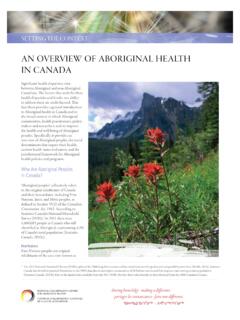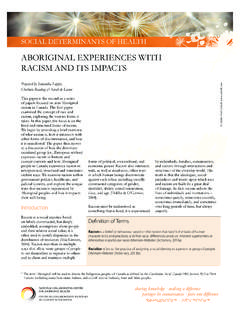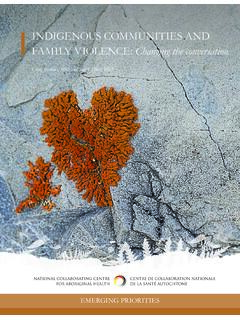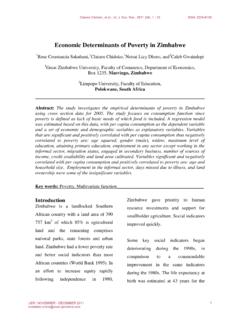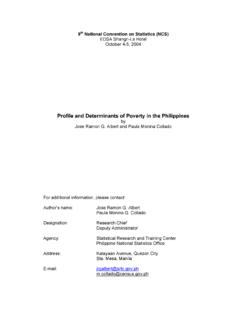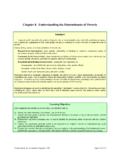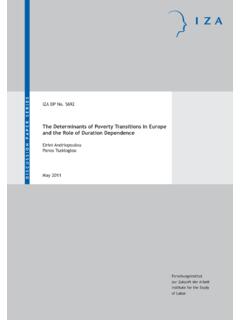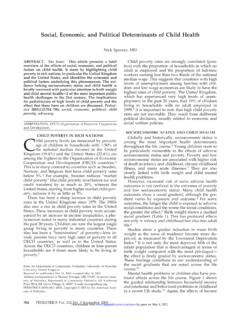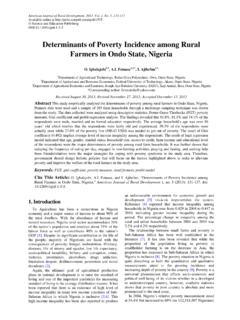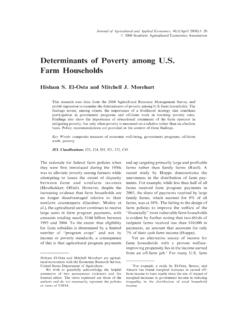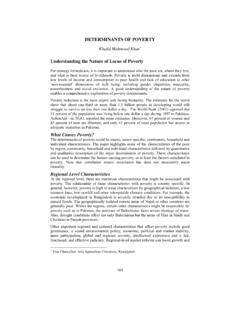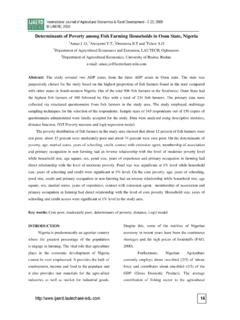Transcription of Poverty as a social determinant for First Nations, Inuit ...
1 social determinants OF HEALTH. Poverty AS A social determinant OF. First NATIONS, Inuit , AND M TIS HEALTH. Credit: Fred Cattroll, , ID 318. Poverty and ill-health are inextricably of which diminishes opportunities, children, ethnic and minority groups, linked. In rich and poor countries limits choices, undermines hope, and and the disabled) and geographic alike, ill-health follows a distinct social threatens health. 2 Poverty has been For Aboriginal i Canadians, gradient: the lower an individual's associated with an increased risk of who experience significantly higher socioeconomic status, the worse their chronic disease, injury, poor infant rates of Poverty and ill-health than the Poverty has many dimensions development, a range of mental health non-Aboriginal population, breaking the material deprivation (food, shelter, issues (stress, anxiety, depression, and Poverty ill-health Poverty cycle sanitation, and safe drinking water), lack of self-esteem)
2 , and premature is critical to improving overall health social exclusion, lack of education, The burden of Poverty falls unemployment, and low income each most heavily on certain groups (women, i Aboriginal' throughout this fact sheet refers collectively to the Indigenous inhabitants of Canada, including First Nations, Inuit and M tis peoples (as stated in section 35(2) of the Constitution Act, 1982). Wherever possible, we provide names and data for distinct groups/communities. sharing knowledge making a difference partager les connaissances faire une diff rence.)
3 Approximately 40% of off- reserve Aboriginal children live in Aboriginal people living in Credit: Fred Cattroll, , ID 205. urban areas are more than twice as likely to live in Poverty than non-Aboriginal people. In 2000. for example, of urban Aboriginal people lived below the Poverty line compared with of Canada's non-Aboriginal urban Rates of Poverty for Aboriginal women are double that of non- Aboriginal As a result of living under conditions of Poverty : More than 100 First Nations communities are currently under boil water advisories and have little Defining and Measuring Poverty Amongst Canada's or no access to clean water for Poverty Aboriginal Peoples drinking and Nearly one in four First Nations Poverty is defined, conceptualized, Research indicates that at best, the adults live in crowded homes and and measured within two broad health situation of Indigenous peoples 23% of Aboriginal people live in frameworks.
4 Absolute Poverty is the mirrors that of the world's poorest, but is houses in need of major severe deprivation of basic human made worse by their social and cultural First Nations suffer from third needs such as food, safe drinking water marginalization. 9 The 1996 Royal world' diseases such as tuberculosis and shelter, and is used as a minimum Commission on Aboriginal Peoples at eight to ten times the rate of standard below which no one should (RCAP) noted that: Canadians in fall regardless of where they It is Aboriginal people in Canada were measured in relation to the Poverty line' Aboriginal people are at the bottom found to be four times more likely or the lowest amount of money needed to experience hunger as a direct of almost every available index of to sustain human life.
5 Relative Poverty result of socio-economic wellbeing, whether More than one quarter of takes a more country specific approach and is defined as the inability to afford [they] are measuring educational Aboriginal people off reserve the goods, services, and activities needed levels, employment opportunities, and 30% of Inuit children have to fully participate in a given In housing conditions, per capita incomes experienced food insecurity at some Canada, Poverty is measured according or any of the other conditions that to the low-income-cut-off' or the give non-Aboriginal Canadians one Aboriginal children are drastically income below which a family is likely of the highest standards of living in overrepresented in the child welfare to spend 20% more of its income on the system.
6 Physical neglect as a result basic necessities than the average family. of Poverty , poor housing and In 2004, approximately million Poverty amongst Canada's Aboriginal substance abuse is a key factor in Canadians were living in Poverty , which population has seen only slight child is more than 11% of the improvements since RCAP. Recent data For Aboriginal peoples, who experience indicates that: poor and unequal living conditions on a national and global scale, Poverty can be One in four First Nations children defined and measured in both absolute live in Poverty as compared to one and relative terms.
7 In six for non-Aboriginal 2. Strategies for Poverty Canadians. Between 1996 and 2006, peoples. 25 Self-determination has the Aboriginal population increased by been identified by the Assembly of Reduction 45%, nearly six times faster than the 8% First Nations' Make Poverty History rate of increase for the non-Aboriginal campaign as critical to the eradication Strategies to alleviate Poverty need to Despite this increase, of Aboriginal This claim is be integrated and multi-faceted. They per capita spending on First Nations supported by research that suggests that require both top-down and bottom- (based on a growth rate of only 23%) is as Aboriginal people expand the scope up approaches that target the full half the amount of average Canadians: and degree of their decision-making range of health determinants such as $7000-$8000 compared to $15,000- power, the chances of sustainable education, employment opportunities, $16, As a result, First Nations economic development rise.
8 27 Control and housing conditions to improve governments are unable to keep up over decision-making reflects Indigenous the living and social environments with the socio-economic demands of a agendas and knowledge, making it more under which people live. The United growing population, particularly with likely that solutions will be appropriate Nations' Millennium Development respect to programs and services. The and viable. It also puts resources which Goals (MDG) of improving global budget cap on services to Aboriginal can be used for social and economic socio-economic conditions by reducing communities must be removed and fiscal development into Indigenous hands, extreme Poverty and hunger identify the arrangements must be developed based fosters civic engagement in economic need for intensive efforts by all parties on real and community development, and to improve governance, actively engage shifts Sustainable and empower civil society.
9 Promote Bottom-up approaches are equally economic development can also provide entrepreneurship and the private sector, important in alleviating Aboriginal employment and capacity building [and] mobilize domestic resources21 Poverty in Canada. It has been opportunities which can improve the There is a central role for national widely argued that unless the economic circumstances of community governments to adopt and implement a particular situation and voices of members, and can generate community development strategy which will improve Indigenous peoples are taken into wealth leading to improved programs the socio-economic circumstances of its account, [there may be] accelerated and services.
10 Self-determination, most vulnerable citizens. loss of land and natural resources, however, must be accompanied with and accelerated assimilation, thus the financial resources to implement In Canada, a key strategy for reducing prolonging and even worsening the decisions. In this, addressing the Aboriginal Poverty is to close the marginalization, discrimination and inequity in federal per capita spending gap in government funding between further impov


